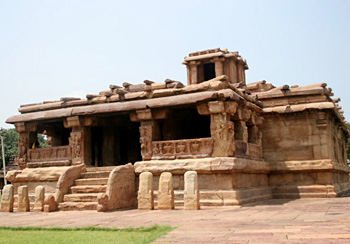 Vastu Shastra includes all types of constructions, including palaces, public buildings, halls, tanks, etc., the majority of surviving structures of ancient days are temples. Hence Vastu-Shilpa generally means the study of temple architectures. Devalaya Vastu is the appropriate word to indicate temple and its architecture. It partly includes sculpture as iconographic details also form part of temple construction.
Vastu Shastra includes all types of constructions, including palaces, public buildings, halls, tanks, etc., the majority of surviving structures of ancient days are temples. Hence Vastu-Shilpa generally means the study of temple architectures. Devalaya Vastu is the appropriate word to indicate temple and its architecture. It partly includes sculpture as iconographic details also form part of temple construction.
Prasada and its construction are dealt with in architecture, and Pratima is the study of iconography. The word `Shilpa` is often used synonymously with sculptural studies, but it has a different meaning altogether. Sashtra and Shilpa are the two faces of the same coin; the former represents theory and the latter refers to the practice or technique. A systematic study of temples essentially include origin and evolution of temple structures, differentiation of traditions and styles, ornamentation and its archaic types, etc.
In Karnataka Prapa is also known as Prapanga. It is without Adhisthana. It is raised above the foundation. The topmost member of the foundation is Homa. Khatapada or Homastambhas are pegged in the Homa structure. These pillars may be wooden or of bamboo with thatched coconut leaves stretched to cover the top. The whole structure may be made out of stone. Thus the description available is about the structure that provides shelter.
Chatuska is four pillared. It may be an independent structure also. It stands in between Prapa and Mandapa. Chatuska gained importance when it occupied central portion in structures, especially Sabha, which will be described later. Chatuska may be opened or closed. When closed it is covered by Bhitti on all the sides. The Mandapa structure that is seen in Puskarini in Mahdkuta, the Nandi Mandapa in Jyotirlinga group of temples at Aihole is to be identified as Chatuska. Though these structures are generally called Mandapas, they are Chatuskas, the early phase in the development of structures; the Prastara above the pillars is not fully evolved.
Mandapa is next to Chatuska. Mandapa is that which protects the decoration. While describing Mandapa the basic aspect of Vastu, i.e. providing shelter or protection to living beings is lost as it protects decoration. The structure of Mandapa is known as Trivarga.
 The growth and development of Mandapa structure, further, is in two directions, vertical and horizontal. The same is known as Urdhva-krama and Tiryak-krama, respectively. In the Urdhvakrama, Chaturvarga structure is known as Lupakara, Panchavarga is Sabha and Sadvarga is Vimana. The details regarding ancient Lupa and Sabha structures are irretrievably lost and presently available features are also scattered. By virtue of the textual explanation Lupa is identified as Chaturvarga.
The growth and development of Mandapa structure, further, is in two directions, vertical and horizontal. The same is known as Urdhva-krama and Tiryak-krama, respectively. In the Urdhvakrama, Chaturvarga structure is known as Lupakara, Panchavarga is Sabha and Sadvarga is Vimana. The details regarding ancient Lupa and Sabha structures are irretrievably lost and presently available features are also scattered. By virtue of the textual explanation Lupa is identified as Chaturvarga.
Lupa temples have sloppy roof which is the Sikhara portion. They are found in western coastal area. Such temples with modern terminology are built even today in Kerala region. The Sikhara portion is mostly made of wooden structure.
Sabha is known as Panchavarga structure according to southern texts wherein the description is not available. Northern texts like the Aparajita-procha and the Samardngana-sutradhdra, however, have descriptions of Sabha. Before the temples took a definite shape, public buildings were utilised to house gods and goddesses, and Sabha is one such structure which is evident from Ladh Khan Temple of Aihole. This temple has stood as a landmark in Karnataka in the origin and development of temple structure.
Ladh Khan Temple is a larger structure with four massive pillars in the middle to form a Chatuska. It is surrounded by Alinda in two stages. The pillars of outer Alinda are smaller than those of the inner Alinda, The sloppy roof extends over the Alinda structure. The outer pillars are inter-connected by Bhitti-palaka or Jalandra. Kudya-stambhas are seen at the corner. Mukhamandapa with Kaksasana is seen in front which provides entrance through Sopana or steps.
The word Vimana is applied to mean Sikhara and above portion of the temple by some scholars. However, it is evident from the above that it refers to the structure from bottom to top in Sadvarga structures.
The southern texts usually refer to Garbhagriha as Vimana, whereas the northern texts identify them as a Prasada. Several scholars name them as southern Vimana and northern Prasdda, respectively. Vimana is pyramidical and Prasada is curvilinear in outline. The Sadvargas of the Vimana are Adhisthana, Pada, Prastara, Kantha, Sikhara and Stupa.









